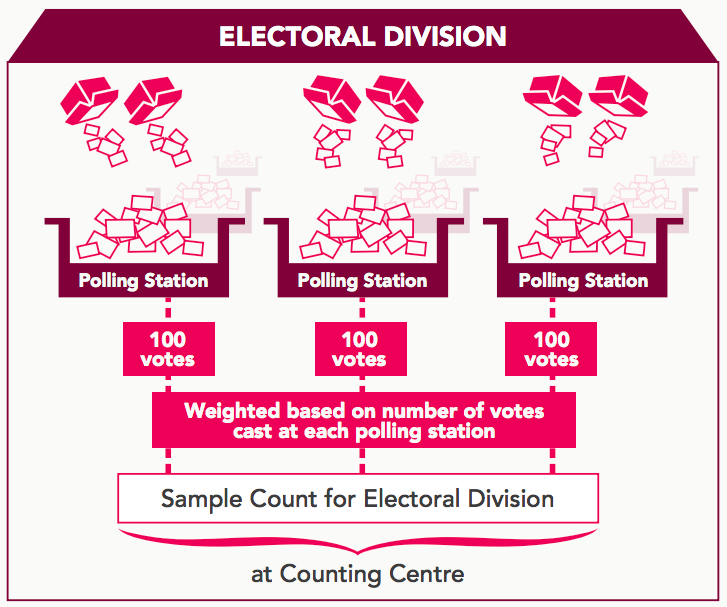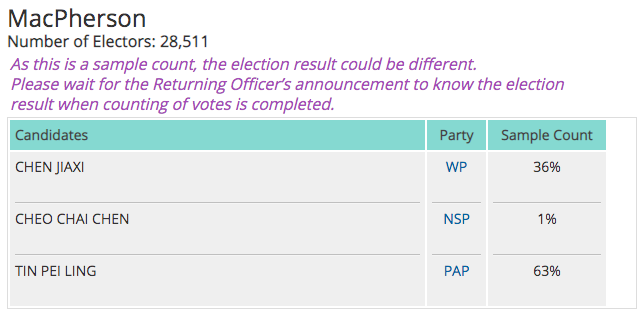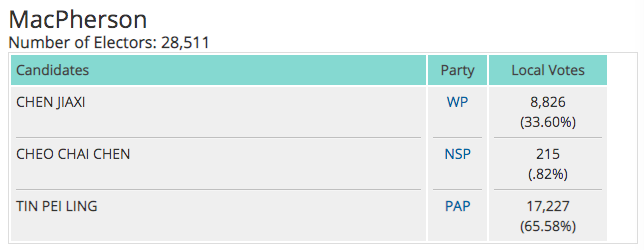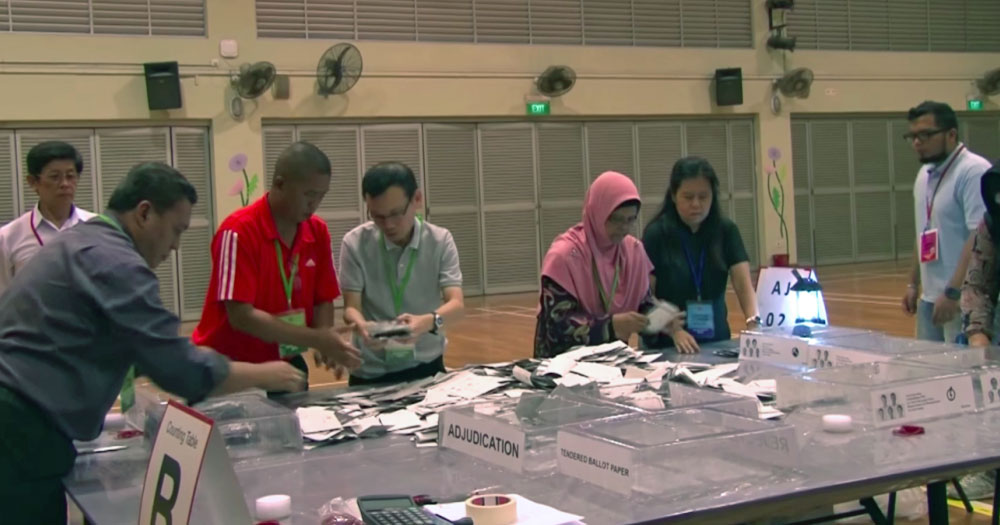With GE2020 campaigning over, all that's left for voters is to cool off, reflect rationally, cast their votes, and then wait for the results.
The official results will be announced live on television on July 10 evening by the Returning Officer after polls close at 8pm and when the votes have been counted.
Prior to the final tally being broadcast, however, a sample count will be published by the Elections Department (ELD).
What is the sample count?
The sample count provides an indication of the results in each constituency, which are obtained by:
- Picking a random bundle of 100 ballot papers from each polling station.
- Counting the 100 votes, with candidates and counting agents present.
- Adding up the votes for each candidate or GRC team, giving more weightage to the bundles from polling stations where more votes were cast.
 Sample count infographic from ELD.
Sample count infographic from ELD.
The sample count for each constituency will be released to the media and published on the ELD website.
Here's what the result for MacPherson SMC looked like in 2015:
 GE2015 sample count results for MacPherson SMC, from ELD website, via web.archive.org.
GE2015 sample count results for MacPherson SMC, from ELD website, via web.archive.org.
And here are the actual results, which are slightly more precise, showing the exact number of votes for each candidate:
 GE2015 results from ELD website, via web.archive.org.
GE2015 results from ELD website, via web.archive.org.
Why release a sample count?
The practice of conducting a sample count is not new — from the 2011 Presidential Election, sample counts were provided to candidates and their counting agents.
However, GE2015 was the first time the sample count was released to the public. Sample counts were also released in the 2016 Bukit Batok by-election.
According to ELD, the sample count is released in order to prevent speculation and misinformation from unofficial sources while counting was underway.
This election, ELD has already had to come out and debunk false rumours about invisible ink in the pens provided for voters, while some may have seen a message with predictions of the results in various constituencies circulated on WhatsApp.
The release of sample counts, together with their track record of accuracy from GE2015, would quickly put to rest any rumours about the results which are significantly different from the early indication.
Are authorities pre-empting "public order incidents"?
Gillian Koh, a Senior Research Fellow at the Institute of Policy Studies, suggested that releasing the sample counts could be a pre-emptive move against different parties' supporters ending up in a "clash over conflicting rumours about how their candidates had done".
This election, the usual practice of supporters congregating on polling day at venues such as stadiums has been ruled out, in view of Phase Two restrictions on large gatherings, thus greatly reducing the possibility of "public order incidents" breaking out.
But the sample counts will be released anyway.
How accurate is the sample count?
Using GE2015 as a gauge, the sample count is highly accurate.
In all constituencies except MacPherson SMC, the results from the sample count came within 2 percentage points of the official results, well below the expected 4 per cent margin of error.
In MacPherson SMC, the sample count indicated a 63 per cent victory for Tin Pei Ling, but the actual result was 65.58 per cent.
On the opposite end of the spectrum, the sample count was most accurate in predicting the winners' margins for the following 10 constituencies:
- Tampines GRC - difference of 0.6 per cent. The sample count predicted that the People's Action Party (PAP) team would win 72 per cent of the vote. They won with 72.06 per cent.
- Pasir Ris-Punggol GRC - difference of 0.11 per cent. The sample count predicted that the PAP team would win 73 per cent of the vote. They won with 72.89 per cent.
- Mountbatten SMC - difference of 0.16 per cent. The sample count predicted that PAP's Lim Biow Chuan would win 72 per cent of the vote. He won with 71.84 per cent.
- Nee Soon GRC - difference of 0.17 per cent. The sample count predicted that the PAP team would win 67 per cent of the vote. They won with 66.83 per cent.
- Radin Mas SMC - difference of 0.25 per cent. The sample count predicted that PAP's Sam Tan would win 77 per cent of the vote. He won 77.25 per cent.
- East Coast GRC - difference of 0.27 per cent. The sample count predicted that the PAP team would win 61 per cent of the vote. They won with 60.73 per cent.
- Marsiling-Yew Tee GRC - difference of 0.27 per cent. The sample count predicted that the PAP team would win 69 per cent of the vote. They won with 68.73 per cent.
- Sembawang GRC - difference of 0.28 per cent. The sample count predicted that the PAP team would win 72 per cent of the vote. They won with 72.28 per cent.
- Tanjong Pagar GRC - difference of 0.29 per cent. The sample count predicted that the PAP team would win 78 per cent of the vote. They won with 77.71 per cent.
- Hougang SMC - difference of 0.31 per cent. The sample count predicted that the Workers' Party (WP)'s Png Eng Huat would win 58 per cent of the vote. He won with 57.69 per cent.
A nail-biting finish could be even more nail-biting because of the sample count
For GE2020, there are a few constituencies where the results are expected to be close.
If the sample count predicts that a given constituency will be won with one side getting 53 per cent of the vote, for example, there is a real chance that the actual count could be 49 per cent or even lower.
There could also be a situation where the sample count predicts that both sides have 50 per cent of the vote, given that winners' actual margins can be thin, with the WP's 50.95 margin in Aljunied GRC being one example.
While the sample counts come with the caution that the actual results could be different, and while their release does nothing to influence the final outcome, Koh also points out that the sample count "may still get emotions fired up" as those concerned would be "on tenterhooks with the heads up about a close call from the official source".
What time can the actual results be expected?
Polling stations will stay open till 8pm, as the law allows for voting from 8am to 8pm, under the Parliamentary Elections Act.
After that, the ballot papers will be brought to a counting centre to be counted.
The sample counts will be available, followed by the actual results.
GE2020 results expected "earlier"
For GE2020, the actual results can be expected "earlier" than in previous elections, according to ELD's election FAQs.
This is because mechanical counting machines will be used to speed up the counting process and reduce the number of officers needed.
The ballot papers will first be manually counted, and then verified using the counting machines.
 Image via ELD.
Image via ELD.
Top image screenshot from Gov.sg on Youtube
If you like what you read, follow us on Facebook, Instagram, Twitter and Telegram to get the latest updates.
